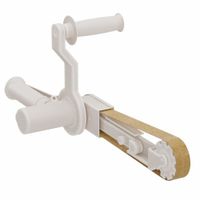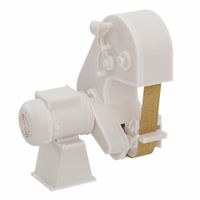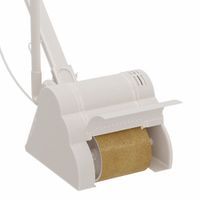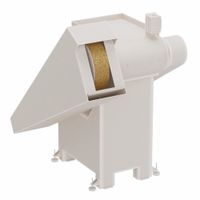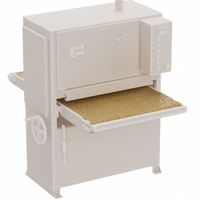Call +(254) 703 030 000 / 751 483 999 / 721 704 777
- Home
- Abrasives
- Sanding Abrasives
- Sanding Belts
.....Read More
Frequently Asked Questions
What are the standard sizes of sanding belts?
Sanding belts come in a variety of standard sizes to fit different types of sanders and accommodate various applications. The most common sizes include:
1. **3 x 18 inches**: Typically used for smaller handheld belt sanders, suitable for light to medium-duty sanding tasks.
2. **3 x 21 inches**: A popular size for home and professional use, offering a balance between control and surface area coverage.
3. **3 x 24 inches**: Provides a larger surface area for more aggressive sanding, often used in professional settings.
4. **4 x 24 inches**: Commonly used for heavy-duty sanding tasks, offering a larger surface area for faster material removal.
5. **6 x 48 inches**: Used in stationary belt sanders, ideal for woodworking and metalworking applications requiring precision and power.
6. **1 x 30 inches**: Typically used in benchtop sanders for detailed work and smaller projects.
7. **2 x 42 inches**: Often used in knife making and metalworking, providing a good balance between size and precision.
8. **2 x 72 inches**: A standard size in knife making, offering a large surface area for efficient material removal and finishing.
9. **4 x 36 inches**: Common in benchtop sanders, suitable for a variety of woodworking tasks.
10. **6 x 89 inches**: Used in industrial applications for large-scale sanding projects.
These sizes are designed to fit specific machines and applications, ensuring optimal performance and efficiency. The choice of size depends on the type of sander, the material being worked on, and the desired finish.
How do I choose the right grit for sanding belts?
To choose the right grit for sanding belts, consider the following factors:
1. **Material Type**: Different materials require different grits. For wood, start with a coarser grit (40-60) for heavy stock removal, then move to medium (80-120) for smoothing, and finish with fine (180-220) for a polished surface. For metal, use coarser grits (40-80) for rust or paint removal, and finer grits (120-400) for finishing.
2. **Project Stage**: The stage of your project dictates the grit. Initial stages require coarser grits for shaping and removing material quickly. Intermediate stages use medium grits for refining the surface, and final stages use fine grits for finishing touches.
3. **Desired Finish**: The smoother the finish you desire, the finer the grit you should use. Coarse grits leave visible scratches, while fine grits produce a smooth, polished surface.
4. **Sanding Belt Type**: Different belts are designed for specific tasks. Open-coat belts are better for softwoods and materials that clog easily, while closed-coat belts are suitable for hardwoods and metals.
5. **Tool Compatibility**: Ensure the grit is compatible with your sanding tool. Some tools may not perform well with very coarse or very fine grits.
6. **Trial and Error**: Sometimes, the best way to determine the right grit is through experimentation. Start with a medium grit and adjust based on the results.
7. **Manufacturer Recommendations**: Follow the manufacturer's guidelines for grit selection based on the material and tool you are using.
By considering these factors, you can select the appropriate grit for your sanding belts, ensuring efficient material removal and a high-quality finish.
Can sanding belts be used on both wood and metal?
Yes, sanding belts can be used on both wood and metal, but there are important considerations to ensure optimal performance and safety.
Sanding belts are versatile tools designed for use with belt sanders, and they come in various materials and grit sizes to suit different applications. For wood, sanding belts are typically made from materials like aluminum oxide or zirconia alumina, which are effective for smoothing surfaces, removing paint, and shaping wood. The grit size can range from coarse (40-60 grit) for heavy material removal to fine (180-320 grit) for finishing.
When using sanding belts on metal, the choice of material and grit is crucial. Zirconia alumina and ceramic are preferred for metalworking due to their durability and ability to withstand the heat generated during metal sanding. Coarser grits (36-60) are used for removing rust or paint, while finer grits (80-120) are suitable for deburring and finishing.
It's important to note that using the same sanding belt on both wood and metal can lead to cross-contamination, which may affect the quality of the finish. Metal particles can become embedded in the belt and scratch wood surfaces, while wood dust can clog the belt and reduce its effectiveness on metal. Therefore, it's advisable to use separate belts for wood and metal to maintain the integrity of the workpiece and the belt.
Additionally, safety precautions should be taken when sanding metal, as it generates more heat and sparks compared to wood. Proper ventilation, protective eyewear, and gloves are recommended to prevent injury and ensure a safe working environment.
In summary, while sanding belts can be used on both wood and metal, selecting the appropriate belt type and grit, and using separate belts for each material, will yield the best results.
How do I replace a sanding belt on a sander?
To replace a sanding belt on a sander, follow these steps:
1. **Unplug the Sander**: Ensure the sander is disconnected from any power source to prevent accidental activation.
2. **Release Tension**: Locate the tension release lever or knob on the sander. This mechanism loosens the belt, allowing for easy removal. Pull the lever or turn the knob to release the tension.
3. **Remove the Old Belt**: Slide the old sanding belt off the sander. If it’s stuck, gently rotate the belt by hand while pulling it off the rollers.
4. **Inspect the Rollers**: Check the rollers for any debris or damage. Clean them with a dry cloth to ensure smooth operation.
5. **Install the New Belt**: Take the new sanding belt and ensure it is the correct size and grit for your task. Align the belt with the directional arrows on the sander, if applicable. Slide the belt over the rollers, ensuring it is centered and aligned properly.
6. **Reapply Tension**: Engage the tension lever or knob to tighten the belt. Ensure the belt is taut and properly seated on the rollers.
7. **Check Alignment**: Manually rotate the belt to check its alignment. It should track straight without slipping off the rollers. Adjust the tracking knob, if available, to correct any misalignment.
8. **Test the Sander**: Plug the sander back in and turn it on briefly to ensure the belt is functioning correctly and tracking properly. Make any necessary adjustments.
9. **Safety Check**: Confirm that all parts are secure and the sander is ready for use.
By following these steps, you can efficiently replace a sanding belt and maintain optimal performance of your sander.
What is the difference between sanding belts and sanding discs?
Sanding belts and sanding discs are both abrasive tools used for smoothing surfaces, but they differ in design, application, and usage.
Sanding belts are continuous loops of abrasive material that fit onto belt sanders. They are ideal for heavy-duty tasks and large surface areas, such as smoothing wooden planks, removing paint, or shaping metal. The belt sander's design allows for rapid material removal, making it suitable for initial rough sanding. Sanding belts come in various sizes and grits, allowing for versatility in different applications. They are particularly effective for straight, flat surfaces and can handle high-speed operations due to their robust construction.
Sanding discs, on the other hand, are circular abrasive sheets that attach to orbital or disc sanders. They are more suited for precision work and finishing tasks. Sanding discs are available in a range of diameters and grits, providing flexibility for detailed work on smaller or contoured surfaces. They are often used for fine sanding, polishing, and finishing tasks on wood, metal, or plastic. The orbital motion of disc sanders helps prevent gouging and provides a smoother finish, making them ideal for delicate surfaces.
In summary, the primary difference lies in their design and application: sanding belts are used for aggressive material removal on large, flat surfaces, while sanding discs are used for precision and finishing work on smaller or contoured surfaces.
How long do sanding belts typically last?
The lifespan of sanding belts can vary significantly based on several factors, including the material being sanded, the type of abrasive used, the pressure applied during sanding, and the specific application. Generally, sanding belts can last anywhere from a few minutes to several hours of continuous use.
1. **Material Being Sanded**: Harder materials like metal or hardwood can wear out sanding belts more quickly than softer materials like pine or soft plastics. The coarseness of the material also plays a role; rough surfaces can degrade belts faster.
2. **Type of Abrasive**: The abrasive material on the belt affects its durability. Common abrasives include aluminum oxide, zirconia alumina, and ceramic. Ceramic belts tend to last the longest, especially for heavy-duty applications, while aluminum oxide is more suited for general-purpose sanding.
3. **Pressure and Speed**: Excessive pressure or high-speed sanding can generate heat, leading to quicker wear and potential belt failure. Proper technique and machine settings can extend belt life.
4. **Application**: Continuous heavy-duty use, such as in industrial settings, will reduce the lifespan compared to intermittent use in a home workshop. Additionally, using the correct grit size for the task can prevent premature wear.
5. **Maintenance and Storage**: Proper storage, such as keeping belts in a cool, dry place, and regular maintenance of the sanding equipment can also impact longevity. Ensuring the belt is properly aligned and tensioned can prevent uneven wear.
In summary, while there is no fixed duration for how long sanding belts last, understanding and optimizing these factors can help maximize their lifespan. Regular inspection and replacement when signs of wear appear, such as fraying edges or loss of abrasive material, are essential for maintaining efficiency and quality in sanding tasks.
Are there specific sanding belts for different types of sanders?
Yes, there are specific sanding belts designed for different types of sanders, and choosing the right one is crucial for optimal performance and results. Sanding belts vary based on the sander type, material, grit size, and intended application.
1. **Sander Type**:
- **Belt Sanders**: These require continuous loop belts that fit the specific dimensions of the sander. They are used for heavy material removal and smoothing large surfaces.
- **Drum Sanders**: These use larger belts or rolls that wrap around a drum, suitable for finishing large, flat surfaces like floors.
- **File Sanders**: These use narrow belts for precision work in tight spaces or detailed areas.
2. **Material**:
- **Aluminum Oxide**: Versatile and durable, suitable for wood, metal, and plastic.
- **Zirconia Alumina**: More durable than aluminum oxide, ideal for heavy-duty sanding on wood and metal.
- **Ceramic**: Extremely hard and long-lasting, perfect for aggressive sanding on tough materials.
- **Silicon Carbide**: Best for sanding non-ferrous metals, glass, and plastics due to its sharpness.
3. **Grit Size**:
- Coarse grits (40-60) for rapid material removal.
- Medium grits (80-120) for smoothing surfaces.
- Fine grits (150-220) for finishing touches.
4. **Application**:
- **Woodworking**: Requires belts that can handle wood grain and resin.
- **Metalworking**: Needs belts that can withstand heat and pressure.
- **Automotive**: Uses belts for paint removal and surface preparation.
Selecting the correct sanding belt involves considering the sander type, material, grit size, and specific application to ensure efficiency and desired results.
